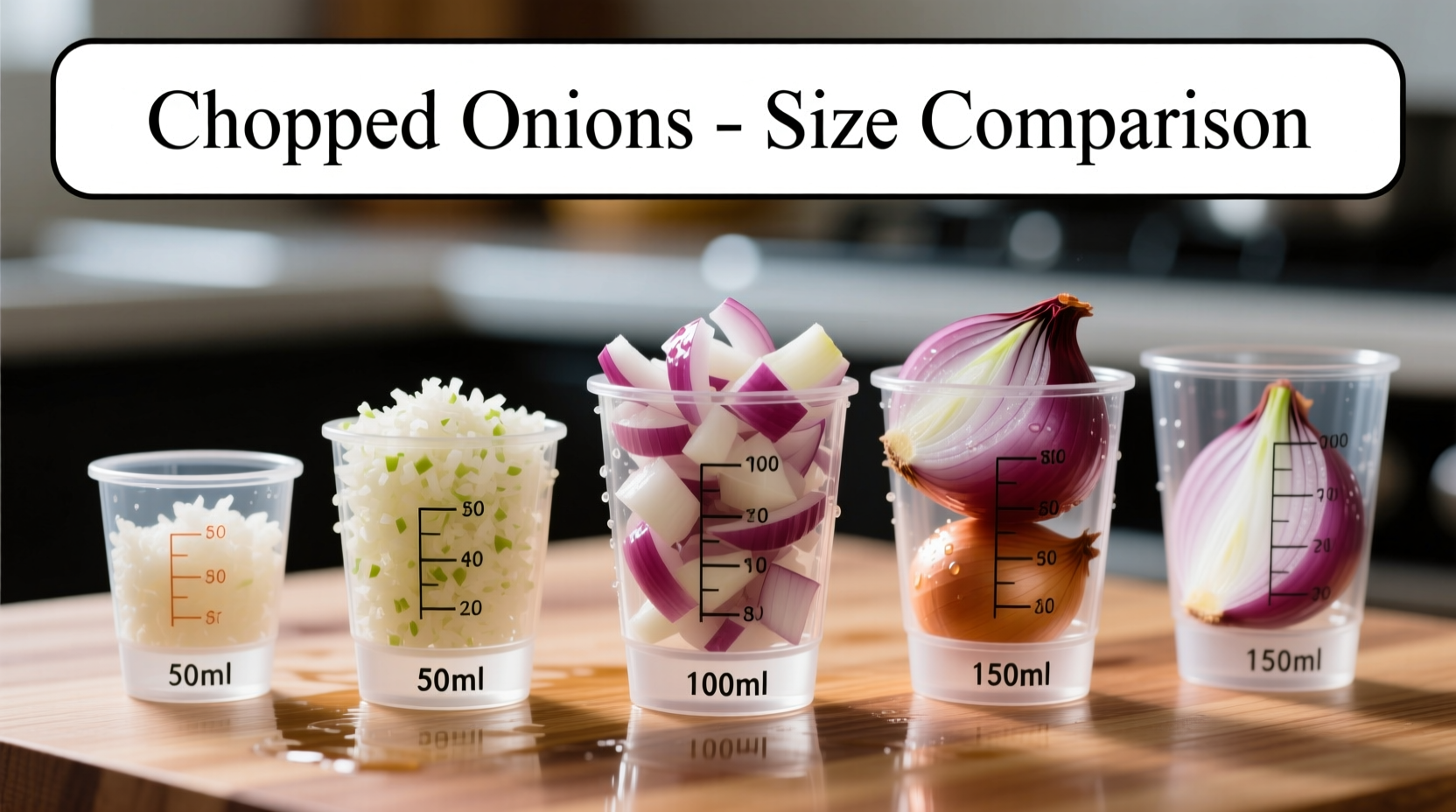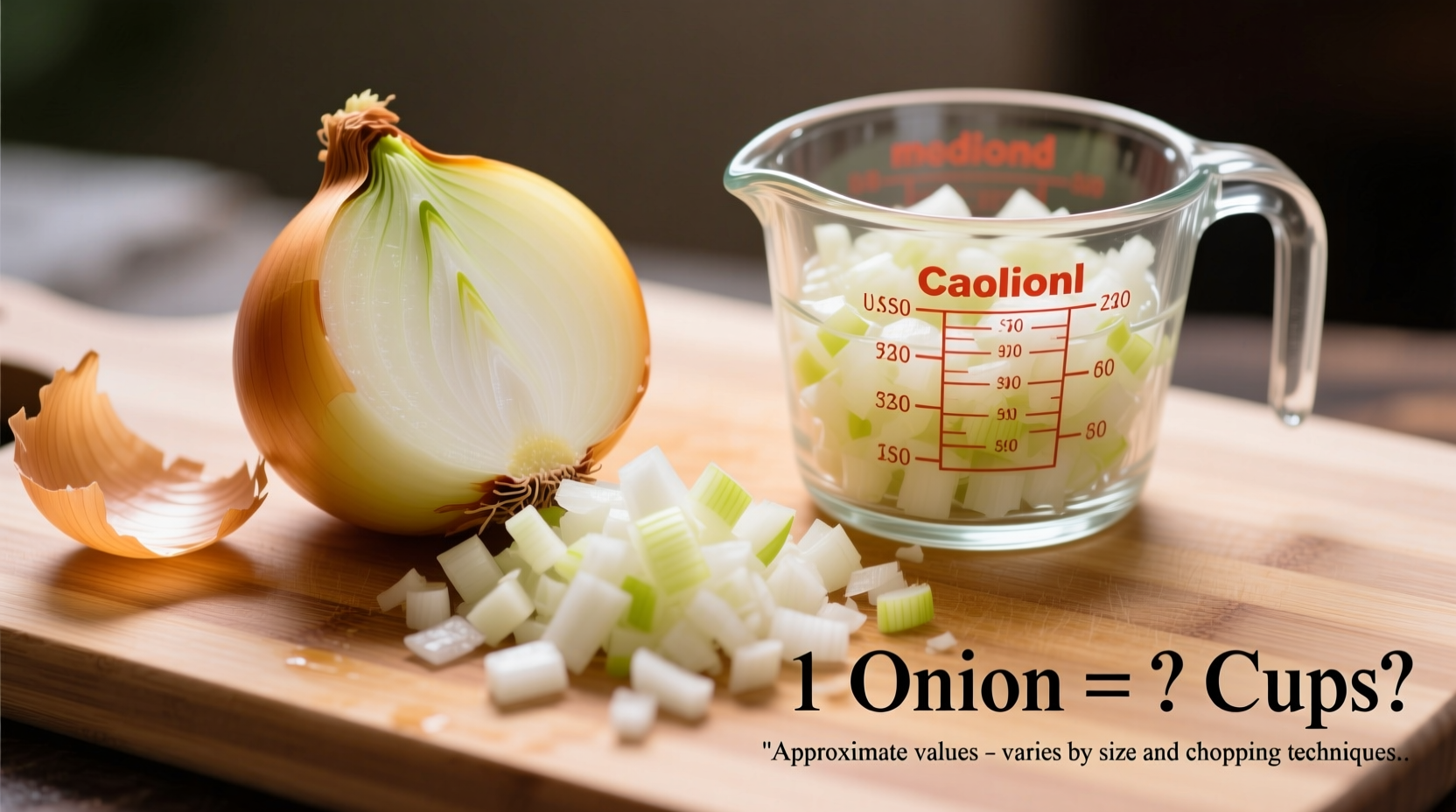Why Onion Measurement Matters in Your Kitchen
Getting onion measurements right can make or break your dish. Whether you're following a family recipe that calls for “one onion” or scaling up for meal prep, understanding the cup equivalent saves guesswork and ensures consistent results. Professional chefs and home cooks alike rely on accurate measurements to balance flavors properly.
Understanding Onion Size Variations
Not all onions are created equal. The size difference between what grocery stores label as “medium” can vary significantly, affecting your final measurement. The USDA defines standard onion sizes by diameter, which directly correlates to volume when prepared:
| Onion Size | Diameter | Weight | Chopped Volume |
|---|---|---|---|
| Small | 2.0-2.5 inches | 3-4 oz (85-113g) | 1/2 - 3/4 cup |
| Medium | 2.5-3.0 inches | 5-6 oz (140-170g) | 1 cup |
| Large | 3.0-3.5 inches | 7-8 oz (198-227g) | 1 1/4 - 1 1/2 cups |
This data aligns with the USDA FoodData Central database, which provides standardized food measurements used by nutrition professionals and culinary experts nationwide (fdc.nal.usda.gov). When precision matters, weighing your onions provides the most accurate starting point.
How Preparation Method Affects Volume
The way you cut your onion significantly impacts the final cup measurement. Here's what happens to volume based on your technique:
- Fine dice (1/8 inch): 10-15% less volume than medium dice due to tighter packing
- Medium dice (1/4 inch): Standard measurement used in most recipes
- Rough chop: 15-20% more volume as pieces don't settle as tightly
- Thin slices: Volume remains similar to medium dice but distributes differently in dishes

Practical Measurement Techniques Without a Scale
When you don't have a kitchen scale handy, these visual cues help estimate onion volume:
- The fist comparison: A medium onion is roughly the size of a clenched fist
- Hand span method: Place your hand flat; a medium onion should fit within your palm
- Measuring cup test: Chop your onion directly into a measuring cup to see where it lands
According to America's Test Kitchen research, the moisture content in onions can vary by up to 10% depending on storage conditions and freshness, which explains why two onions of identical size might yield slightly different volumes when chopped (americastestkitchen.com). For critical recipes, especially baking or canning, weighing provides the most reliable measurement.
When Precision Really Matters
While many savory dishes tolerate some variation in onion quantity, certain recipes demand accuracy:
- Pickling and canning: Exact vegetable-to-liquid ratios affect preservation safety
- Baking savory items: Excess moisture from too many onions can alter texture
- Sauces and dressings: Onion quantity directly impacts flavor balance
- Meal prep for dietary needs: Precise carb counting requires accurate measurements
For everyday cooking, the “medium onion = 1 cup chopped” guideline works perfectly. But when following recipes from professional sources that specify cup measurements rather than “one onion,” understanding these conversions ensures your dishes turn out as intended every time.
Pro Tips for Working with Onions
Professional chefs use these techniques to maximize flavor and minimize waste:
- Chill onions for 30 minutes before chopping to reduce tearing
- Use the entire onion including the root end (after removing the tough core)
- Store chopped onions in airtight containers for up to 5 days
- Freeze excess chopped onions in 1-cup portions for future use
- Remember that red onions pack slightly more volume than yellow onions of the same size
Understanding how many cups is one onion transforms your cooking from guesswork to precision. Whether you're meal prepping for the week or following a cherished family recipe, these measurements help you achieve consistent, delicious results every time.
Frequently Asked Questions
How many cups is one large onion when diced?
A large onion (approximately 3.5 inches in diameter) yields 1 1/4 to 1 1/2 cups when diced. The exact amount depends on your chopping technique and the onion's moisture content.
Does the type of onion affect the cup measurement?
Yes, different onion varieties have slightly different densities. Yellow cooking onions follow the standard measurements, while red onions typically yield about 10% more volume and sweet onions like Vidalias yield 5-7% less volume when chopped.
How do I convert a recipe that calls for “one onion” to cup measurements?
Assume “one onion” means one medium onion unless specified otherwise, which equals approximately 1 cup chopped. For recipes serving 4-6 people, this conversion works well. For larger batches, consider weighing onions for more precise scaling.
Why does my chopped onion measure less than expected?
Several factors can reduce volume: using a fine dice (pieces pack tighter), older onions with less moisture, or pressing down on the measuring cup. For most recipes, a slight variation won't affect the final dish significantly.
Can I substitute dried onion for fresh in cup measurements?
No direct substitution works perfectly, but as a general rule: 1 tablespoon dried onion flakes equals approximately 1/4 cup fresh chopped onion. Dried onion has concentrated flavor and lacks the moisture of fresh, so adjust liquids in your recipe accordingly.











 浙公网安备
33010002000092号
浙公网安备
33010002000092号 浙B2-20120091-4
浙B2-20120091-4